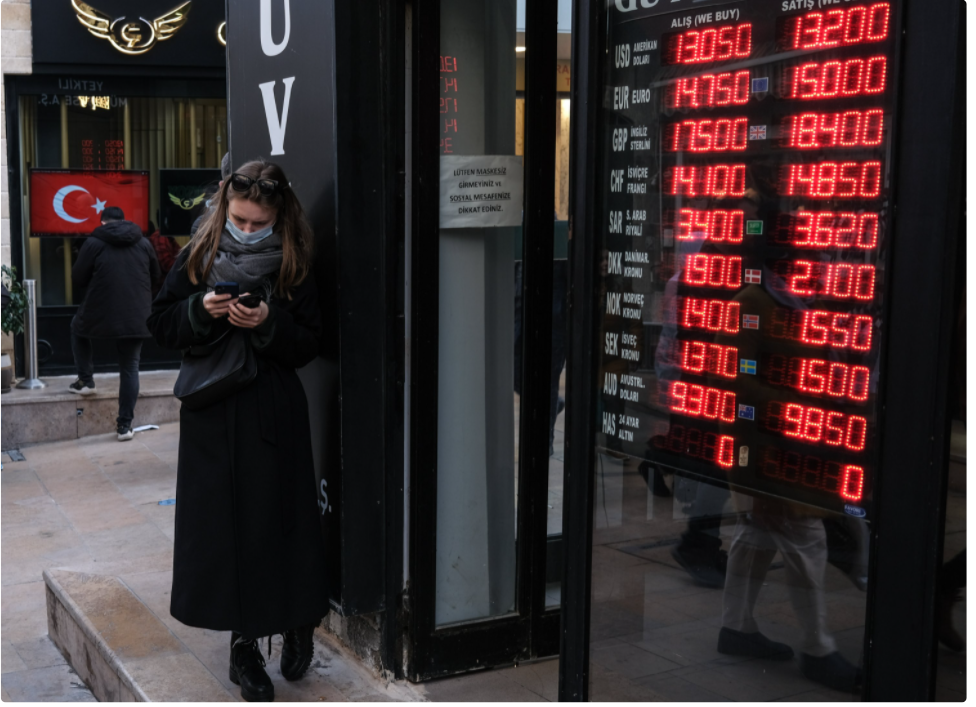Turkish authorities either deny intervening in the currency market, or answer questions about the subject. Ankara has a vested stake in presenting the exchange rate as the natural equilibrium of supply and demand, because Erdogan hopes to convince FX-loving country people to swap them for his new invention, the FX-protected TL deposit plan. After the Reuters news, which PA quotes in this article, Erdogan’s plan is largely muted.
Reuters reported on 31st of January that Turkey’s central bank has spent as much as $1 billion last week to keep the lira steady after last month’s extreme volatility, according to the calculations of bankers and economists.
Data shows the bank sold nearly $20 billion in foreign reserves in December to underpin the currency as it whip-sawed from 18.4 to 10.25 against the dollar, rattling the major emerging market economy and sending inflation soaring.
This month, the lira has settled into a tight range around 13.5 that several bankers described as a managed exchange rate or “dirty float”, after the government took several steps to boost public confidence and official reserves.
Among the measures are central bank purchases of 25% of exporters’ hard currency revenues and entire payments from foreigners into a citizenship-for-homes programme, as well as hard currency transfers into a new deposit-protection scheme.
Four bankers told Reuters the measures have beefed up central bank currency reserves, even as data suggested the bank continued to sell dollars, albeit at a smaller scale than in December when they were easier track.
WATCH: Has Erdogan Averted a Currency Crisis? | Real Turkey
The central bank’s reserves were $600 million to $1 billion short of what would have been expected after last week’s dollar-buying, according to three bankers’ calculations of leading indicators and official data.
That suggests the dollar-selling interventions totaled $600 million to $1 billion, they said, citing central bank balance sheet and reserves data, as well as lenders’ official deposits.
“The central bank not only buys some foreign currency that comes to the market but also its reserves sales are continuous, (resulting in) a forex regime directed by the state,” said a senior banker who requested anonymity.
The central bank has not formally announced a market intervention since mid-December. It declined to comment on any recent interventions and the bankers’ calculations.
Bank Governor Sahap Kavcioglu on Thursday downplayed claims of reserve sales and repeated no interventions took place on Dec. 20 when the lira mounted its all-time biggest daily rally. He told a news conference that a drop in net foreign reserves to $7.55 billion in mid-January, a 20 year low, was due to market volatility and demand from state institutions.
WATCH: TURKEY: Next Stop Is Currency Controls | Real Turkey
Finance Minister Nureddin Nebati has said state entities have a duty to intervene to stabilize the currency as needed.
CAN IT LAST?
Despite last year’s costly interventions, the lira shed 44% of its value in 2021 due largely to unorthodox interest rate cuts urged by President Tayyip Erdogan whose sweeping new economic programme focuses on exports, credit and investment.
Authorities have not revealed how much the bank has purchased from exporters nor from foreign home-buyers under the new measures adopted this month, leaving it to the bankers to estimate their volumes, and consequently the scale of market interventions.
Marek Drimal at Societe Generale said, however, focusing monetary policy on the currency “may prove very challenging”, given expected further rise in inflation and seasonal current account swings are likely to keep the lira volatile.
He said, for now “intervention is likely to be on the table” to stop lira sliding beyond 14 to the dollar.
Bloomberg: Turkey Asks People to Ditch Dollars for Lira Savings
The Turkish government is pushing its lira-rescue plan to a new level: an advertising campaign to convince people to convert their savings to the local currency, reported Bloomberg, which explains the “stealth intervention” .
A video broadcast on national television and social media on Sunday praises citizens’ hard work and asks them to invest their savings into Turkish lira time deposits that offer protection from currency depreciation.
President Recep Tayyip Erdogan introduced a set of measures on Dec. 20 to halt the collapse, and the currency has been relatively stable this month. The central bank has also placed the lira at the center of its policy and promised the protect it.
Erdogan’s game plan rests on keeping the exchange rate stable for as long as frustrated FX holders switch to TL. While in theory the yield gap between artificially low value of FX and TL deposit would achieve this goal, in practice it is futile. This is because most savers hold FX not to arbitrage interest rate differentials but as protection against inflation risk.
Since the lag between exchange rate fluctuations and inflation is long, and the pass through coefficient at around 30%, a stable TL will not necessarily lower inflation immediately.
Follow our English language YouTube videos @ REAL TURKEY: https://www.youtube.com/channel/UCKpFJB4GFiNkhmpVZQ_d9Rg
And content at Twitter: @AtillaEng
